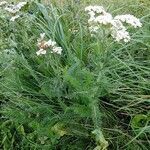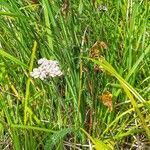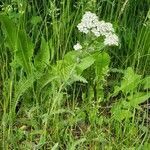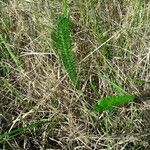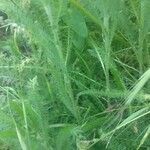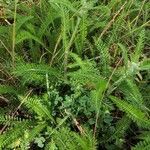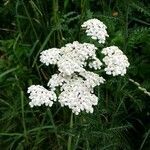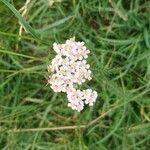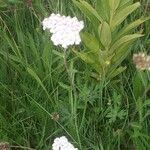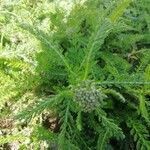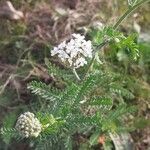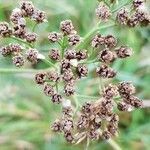Herbs, perennial, 40-100 cm tall, with long rhizomes; stems erect, unbranched or branched in upper part, often with short sterile branches at leaf axils above middle, striate, usually white villous. Leaves sessile; leaf blade lanceolate, oblong-lanceolate, or sublinear, 5-20 × 1-2.5 cm, (2 or)3-pinnatisect, abaxially densely villous, adaxially densely depressed glandular punctuate; ultimate segments lanceolate to linear, 0.5-1.5 × 0.3-0.5 mm, apex cartilaginous-mucronulate. Synflorescence a terminal flat-topped panicle 2-6 cm in diam. Capitula many. Involucres oblong or subovoid, ca. 4 × 3 mm; phyllaries in 3 rows, elliptic or oblong, 1.5-3 × 1-1.3 mm, scarious margin pale yellow or brown; midvein convex. Paleae oblong-elliptic, scarious, abaxially yellow gland-dotted. Ray florets 5; lamina white, pink, or violet-red, suborbicular, 1.5-3 × 2-2.5 mm, apex 2-or 3-denticulate. Disk florets yellow, tubular, 2.2-3 mm, exterior gland-dotted, apex 5-lobed. Achenes greenish, oblong, ca. 2 mm, with white lateral ribs. Corona absent. Fl. and fr. Jul-Sep. 2n = 18, 27, 36 + 0-2B, 45, 54 + 0-3B, 72.
Strongly scented, rhizomatous herb, with short non-flowering rosettes often forming dense mats. Stems usually erect, sometimes ascending, up to c. 80 cm tall, ribbed and striate, hairy especially above, usually not branched except above to form infl. Basal lvs petiolate, lanceolate, moderately hairy, 2-pinnate with segments again 1-2-pinnatisect, 6-15-(44) × 1-2-(4) cm; primary leaflets in 18-30-(37) pairs; ultimate segments subulate, not all in one plane giving a feathery appearance to lf; rachis c. 1-2 mm diam., flattened, sometimes slightly winged, not toothed. Cauline lvs similar to basal, but above becoming apetiolate, less divided, smaller, and with fewer leaflet pairs. Corymbs usually ± flat-topped or slightly convex, to c. 15 cm across, with numerous, closely packed capitula. Involucral bracts glabrous to sparsely hairy, 1.5-4-(5) mm long; margin brown, hairy. Capitula (3.5)-5-10 mm diam.; ray florets 4-7; ligule and disc florets usually white, sometimes pink to deep red or purple. Achenes grey-brown, c. 2 mm long; wings narrow, pale brown.
Perennials, 6–65+ cm (usually rhizomatous, sometimes stoloniferous). Stems 1(–4), erect, simple or branched, densely lanate-tomentose to glabrate. Leaves petiolate (proximally) or sessile (distally, weakly clasping and gradually reduced); blades oblong or lanceolate, 3.5–35+ cm × 5–35 mm, 1–2-pinnately lobed (ultimate lobes ± lanceolate, often arrayed in multiple planes), faces glabrate to sparsely tomentose or densely lanate. Heads 10–100+, in simple or compound, corymbiform arrays. Phyllaries 20–30 in ± 3 series, (light green, midribs dark green to yellowish, margins green to light or dark brown) ovate to lanceolate, abaxial faces tomentose. Receptacles convex; paleae lanceolate, 1.5–4 mm. Ray florets (3–)5–8, pistillate, fertile; corollas white or light pink to deep purple, laminae 1.5–3 × 1.5–3 mm. Disc florets 10–20; corollas white to grayish white, 2–4.5 mm. Cypselae 1–2 mm (margins broadly winged). 2n = 18, 27, 36, 45, 54, 63, 72 (including counts from Europe).
Rhizomatous perennial herbs, to c. 60 cm high, moderately pubescent. Leaves to c. 8 cm long, 2-or 3-pinnatisect, with segments arranged 3-dimensionally in fresh state; rachis of mid-stem leaves 0.6–1.2 mm wide, mostly entire between primary segments, sometimes dentate. Capitula in dense corymbiform inflorescences, 4–8 mm diam.; peduncle to c. 1.0 cm long, slightly to moderately hairy; involucre 3.0–4.5 mm long; bracts keeled; outer and middle series of bracts with margin light or often dark brown; inner bracts with hyaline extension c. 0.3 mm long; paleae 3–4 mm long. Ray florets c. 5; ligule 2–3 mm long, white or less often pink to purple. Disc florets c. 8; corolla c. 2 mm long; tube narrower than and ±as long as limb; limb white. Achenes c. 2 mm long.
Perennial herb, up to 500 mm high, strongly aromatic. Leaves alternate; sessile; blade linear or narrowly elliptic in outline, 2 x or 3 x pinnate, ultimate segments very narrow, sparsely hairy. Heads radiate, small, crowded in terminal corymbs. Involucral bracts in a few rows, imbricate. Receptacle paleate. Flowers: ray florets female, fertile, usually white, sometimes rosy; disc florets bisexual, fertile, white or creamy white; Nov.-Apr. Fruit with cypsela compressed, narrowly obovate, with 2 lateral ribs, glabrous. Pappus absent.
A herb which keeps growing year after year. It grows 0.6 m high and spreads 0.4 m across. It has a creeping rootstock. The stems are usually unbranched and are woolly. The stems are erect and flowering. The leaves occur one after another on opposite sides of the stalk. They are divided into many small feather like segments. The leaves are 10 cm long. The flowers are white and like a daisy flower. They occur in flattened compound flower heads.
Perennial herb, up to 500 mm high, strongly aromatic. Leaves alternate, 2x or 3x pinnate, ultimate segments very narrow, sparsely hairy. Capitula radiate, small, crowded in terminal corymbs. Receptacle paleate. Ray florets usually white, sometimes rosy. Disc florets white or creamy white. Flowering time Jan.-Apr. Pappus absent. Cypselae narrowly obovate, compressed.
Perennial herb, up to 500 mm tall, strongly aromatic. Leaves 2 or 3 times pinnate, ultimate segments very narrow. Heads crowded in terminal corymbs. Pappus absent. Flowers with rays usually white, sometimes rosy, disc white or creamy white.
